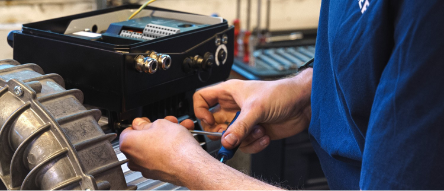Symptoms of a Bad Vacuum Pump
Vacuum pumps provide a critical service in a wide range of situations where an interruption to supply can have serious consequences. From medical facilities and agriculture to uninterruptible manufacturing processes, unplanned disruptions can lead to unsafe conditions and trigger costly shutdowns and production losses. In situations like these, it’s crucial... The post Symptoms of a Bad Vacuum Pump appeared first on Becker Pumps.

Vacuum pumps provide a critical service in a wide range of situations where an interruption to supply can have serious consequences. From medical facilities and agriculture to uninterruptible manufacturing processes, unplanned disruptions can lead to unsafe conditions and trigger costly shutdowns and production losses.
In situations like these, it’s crucial to spot symptoms of a malfunctioning pump early so repairs can be made quickly and disruption can be minimized.
In this article, we outline several telltale symptoms of misfiring vacuum pumps, as well as likely causes and recommended interventions to protect your equipment and processes. Read on to learn what are the symptoms of a bad vacuum pump.
6 COMMON SIGNS OF VACUUM PUMP TROUBLE
Let’s take a closer look at these six signs of vacuum pump underperformance.
1. EXCESSIVE VANE NOISE
While many “oil-less” dry vane pumps experience clicking sounds at start-up or shutdown, ongoing clattering, thumping, or groaning sounds may mean trouble with the pump’s internal vanes.
Dry pump vanes are designed to come into contact with the cylinder wall and to wear down at a set rate, as indicated on the maintenance tag fixed to the top of all Becker pumps. If vanes are wearing too fast this may lead to excessive noise. Loose parts from chipped or broken vanes will cause loud rattling sounds, almost as if the pump contained glass marbles.
Worn or broken vanes will affect pump efficiency and need to be replaced. New vanes will often make a screeching sound for about 10 minutes as they begin to “mesh” with the cylinder wall. Becker recommends running the pump under ambient air for 3-5 minutes and then under full load for 3-5 minutes until the vanes have fully meshed and the sound decreased.
In oil-flooded pumps, clicking or clattering sounds indicate that vanes that should be fully lubricated are operating dry, indicating that oil has congealed, burned, or become contaminated. Dry blades will pump less efficiently and may cause catastrophic pump failure if one or more blades break.
Routine maintenance of both dry and oil-flooded vacuum pumps will help extend vane life and prevent problems before they occur.
2. PUMP FAILS TO START
A pump that fails to start on installation has usually not been installed properly or has been attached to the incorrect voltage. For Becker Pumps, refer to the motor nameplate and wiring diagram for the correct installation.
An installed pump that fails to start up has most likely tripped its circuit as the result of a mechanical or electrical failure. Double-check that all electrical wiring is correct and that there are no loose connections. Use a screwdriver or other tool to gently turn the motor fan to check for mechanical lock-up. The fan should turn one full revolution without getting stuck. If it fails to restart or trips again, disconnect the pump from the power and contact a certified factory-trained Becker technician to check for issues.
3. LOW OR NO VACUUM
Partial or complete loss of vacuum, slow pump down rates, or similar performance issues can be the result of several things:
- Pressure leaks: Ensure all connections to the pump are tight and secure and gaskets and seals are intact.
- Worn consumable parts: Check vanes routinely to ensure they are wearing normally and not broken, chipped, or cupped from excessive heat. There will be performance loss over time as vanes wear down.
- Contaminated or incorrect grade oil: Oil-filled pumps need the correct grade and filtration to ensure the oil does not become contaminated. Congealed oil can lead to blades becoming stuck to rotor slots.
- Poor filtration: Clogged or excessively dirty filtration can result in overheating and could cause catastrophic pump failure, leading to a complete loss of vacuum. Regular maintenance with approved parts is critical.
- Incorrectly adjusted valve: Request a certified Becker technician to inspect the vacuum relief valve once other causes of pressure loss have been eliminated. Adjusting the valve to compensate for worn vanes may damage the valve.
4. HIGH AMPERAGE
Straining or overheating equipment may draw more power than is safe. Correctly installed equipment will trip the circuit breaker if this occurs. Higher than rated amperage may be the result of:
- Poor filtration: Clogged inlet filters can put extra load on the pump causing amperage to increase.
- Friction: Excessive mechanical friction, such as rotor-to-end-shield contact or failing bearings, may result in the motor drawing more power.
- Incorrect voltage: Be sure that your pump is connected to a power source for which it is voltage-rated. Check that the rating on the pump motor matches the power source.
5. CARBON DUST EMITTING FROM EXHAUST
Black smoke and dust from an oil-less vacuum pump’s exhaust is usually a sign of vane failure and should be accompanied by a pressure loss. Shut down your pump and inspect the working chamber for signs that vanes have been damaged by contact with the cylinder wall or a foreign object.
If no contact is found and replacing the vanes does not solve the problem, contact a Becker Service Center to have your pump inspected.
6. OIL MISTING FROM EXHAUST
Oil misting from the exhaust of an oil-flooded vacuum pump can have a couple of causes:
- Failing oil separators: Saturated or clogged filters, or contaminated oil can result in oil mist being blown out of the pump’s exhaust. Change out the filter elements and replace the oil.
- Insufficient vacuum: Oil-flooded pumps run better at their deep-rated vacuums. If your pump is running at low vacuum levels for too long or suffers a plumbing leak, then the higher air flow in the pump will cause oil to mist out of the exhaust. This overloads the oil separation elements faster than normal.
The following table summarizes potential vacuum pump problems, their likely causes, and preferred solutions.
Symptom Likely Cause Solution Excessive vane noise Dry vane pumps: Vane wear below specification or vane damage.
Oil-flooded pumps: Burned, dried, or contaminated oil, dry running.Dry vane pumps: Replace vanes, run the pump open to ambient air and under full vacuum in cycles.
Oil-flooded pumps: Replace oil, replace damaged vanes.Pump fails to start Incorrect voltage setting, mechanical or electrical failure. Check voltage settings on tag plate, reset breakers, request a mechanical and electrical check by a certified technician. No vacuum/vacuum loss Leaks: Check for loose connections, blown seals.
Wearable parts: Look for worn vanes.
Contaminated/incorrect oil: Clogged, struck vanes.
Filtration: Overheating from restricted filtration.
Valve: Malfunctioning valve.Tighten connections, replace worn vanes, ensure correct oil usage and filtration, and consult a technician for valve issues. High amperage Poor filtration: Strain on the pump.
Friction: Mechanical friction in the pump chamber.
Incorrect voltage: Wrong voltage for motor.Address filtration issues, correct mechanical friction, check and adjust voltage settings. Carbon dust blowing from exhaust Vane failure, obstructions in the working chamber. Shut down the pump, inspect and replace vanes, and consult the service center for pump evaluation if needed. Oil misting from exhaust Oil separator: Contaminated or saturated oil separator.
Low vacuum level: Running at inadequate vacuum levels or exposure to ambient leaks.Change oil and filter elements, address vacuum levels, and check for leaks.
FREQUENTLY ASKED QUESTIONS
Q: What are the key preventative maintenance measures every pump owner should take to avoid vacuum pump issues?
A: Many problems can be avoided by inspecting the filtration, vanes, oil, and grease according to the recommended maintenance intervals of your pump type. Bear in mind that most vacuum pumps in continual use will need to be overhauled at least once in their lifetime.
Q: Are there any signs/issues that a vacuum pump may be unsafe to test or repair?
A: Do not attempt to repair a motor that has developed an internal short or other electrical issues. Contact an authorized Becker Service Center for repairs. Also, be cautious when handling pumps that might have been used to pump corrosive matter or very fine particulates or come into contact with these materials. Always wear the required PPE for your application.
Q: Are there signs that a functioning pump may develop trouble in the future?
A: Excessive noise, increasing heat or amperage and occasional chipped or broken vanes may all be signs of washboard, where regular wear causes cylinder walls to develop slight ripples and waves. Your pump will likely continue to operate well for some time but once washboarding has begun it cannot be reversed.
RUN BETTER. MAKE IT BECKER

When you buy a Becker vacuum pump, you’re buying quality, industrial-grade equipment that’s designed to keep performing in the toughest real-world conditions for years to come. That’s why we back up every pump we ship with industry-leading technical support, troubleshooting, and parts.
Our highly qualified, factory-trained technicians come to you to help inspect, troubleshoot, or repair equipment on-site. We can help with routine maintenance and spot issues long before they become serious, equipment life-limiting problems.
For more comprehensive work, we offer pump rental services so you can maintain operations while your equipment is being repaired or overhauled at one of our authorized service centers or rebuilt at our Ohio factory.
We’re also available to answer questions, provide training resources, and ship you the quality, original parts you need when you need them.
For bottom-line benefits out of the box and long-term savings on energy and maintenance, pick smarter, make it Becker. Get in touch today to find out how we can help you.
The post Symptoms of a Bad Vacuum Pump appeared first on Becker Pumps.

 nikhil
nikhil 





